
Kale, cabbage, onions, garlic and broccoli are some of the most nutritious foods out there, but have you ever wondered what makes them so healthy? In addition to vitamins, minerals and antioxidants, they contain sulfur, which is essential for healthy cells and tissues.
Sulfur is an essential mineral that has a wide range of health benefits. Regularly eating garlic and other foods high in sulfur is linked to reduced oxidative stress and inflammation as well as higher antioxidant levels, per a December 2014 review in Molecules.
Video of the Day
Video of the Day
Potential Health Benefits of Sulfur
Sulfur is one of the most important minerals in the human body and a key part of several amino acids, including methionine and cysteine, per a December 2015 report in the Annual Review of Nutrition.
Some potential health benefits of sulfur include:
- Easing arthritis pain
- Treating skin conditions
- Supporting liver health
Sulfur is used in a variety of dietary supplements, especially those designed for people with arthritis. Methylsulfonylmethane (MSM), for instance, is a popular supplement. This sulfur compound may help relieve pain and inflammation, according to the Arthritis Foundation.
You'll also sulfur as an active ingredient in some skincare products. Topical lotions or creams containing sulfur may help prevent acne breakouts and treat dandruff, seborrheic dermatitis and scabies, per the Mayo Clinic. But using topical sulfur may cause skin dryness and irritation in some people.
Glutathione, an antioxidant made with the help of sulfur, plays an important role in liver detoxification, per an August 2017 pilot study in BMC Gastroenterology. Eating sulfur-rich foods can help supply the sulfur needed to create this important antioxidant.
Potential Side Effects of Too Much Sulfur
While sulfur is essential to survival and found in every human cell, there are some potential dangers of eating too much sulfur.
While not common, some people may be intolerant or allergic to sulfur. In one case, a physically fit woman experienced swelling of the mouth and throat, low blood pressure and itching after having energy drinks and sports supplements with sulfur-containing compounds, such as taurine, per a January 2014 case study in Food and Chemical Toxicology.
Sulfur is low in toxicity, but eating too much could cause diarrhea, per the National Pesticide Information Center. Chances are you won't experience these symptoms from eating too many foods rich in sulfur — these bad reactions are more likely to occur if you have a sulfur allergy.
Foods High in Sulfur
1. Garlic and Onions

Garlic, onions, leeks and other vegetables in the allium family are among the best sources of sulfur. These foods boast high doses of allicin, alliin and diallyl sulfide as well as phytonutrients, according to a December 2014 study in the Journal of Food and Drug Analysis.
Cooking destroys the enzyme alliinase and reduces allicin levels in garlic, per the Linus Pauling Institute at Oregon State University. To fully reap garlic's health benefits, add freshly crushed garlic to your meals.
2. Cruciferous Vegetables
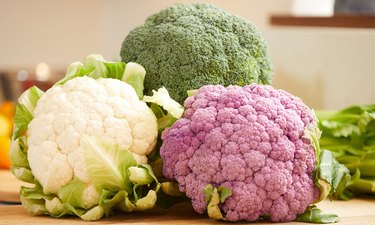
Cauliflower, broccoli, cabbage and other cruciferous veggies are rich in sulforaphane, a compound that's linked to protection against several types of cancer and DNA damage, per a July 2017 article in Critical Reviews in Food Science and Nutrition.
People who eat cruciferous vegetables regularly were observed to have a lower risk of breast, prostate and colorectal cancer as well as heart disease, according to a May 2015 review in the journal Antioxidants & Redox Signaling.
Cruciferous vegetables can also bring you closer to your weight loss goals. They're high in fiber and low in calories, keeping you full for hours. One cup of chopped broccoli, for example, has only 31 calories, 6 grams of carbs and 2.4 grams of fiber.
3. Eggs

If you've ever smelled a rotten egg, you know what sulfur smells like. Eggs are rich in methionine, a sulfur-containing amino acid. This natural compound regulates the immune system and metabolic processes. It also supports glutathione synthesis, protecting your cells and tissues from oxidative stress, per a September 2017 review in Amino Acids.
In addition to sulfur, eggs are a good source of protein and B-complex vitamins. One large egg provides more than 6 grams of protein and just 72 calories. Plus, it's rich in vitamin A, vitamin D, vitamin B12, riboflavin, selenium and phosphorus. If scrambled eggs are getting boring, try one of these fun egg recipes.
4. Meat and Poultry

Meat and poultry are rich in sulfur-containing amino acids, such as cysteine and methionine. Due to their high protein content, meat and poultry increase satiety and can help you manage your weight with their appetite-suppressing effects.
Enjoy a variety of lean animal proteins in moderation to stay full longer and get an ample supply of sulfur.
5. Fish
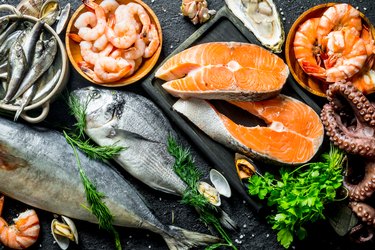
Crab, mussels, haddock, prawns, scallops and cod all contain methionine, a sulfur-containing amino acid. Cod contained the most sulfur out of 32 foods tested, per a November 2017 study in Food Chemistry.
Not only does fish supply sulfur, but it's also one of the best sources of omega-3 fatty acids. This unsaturated fatty acid helps to reduce inflammation in the body, lowering your risk for heart disease, per the Mayo Clinic. Eating 8 ounces of fish per week is recommended by the U.S. Food and Drug Administration (FDA) to get your omega-3s.
6. Legumes
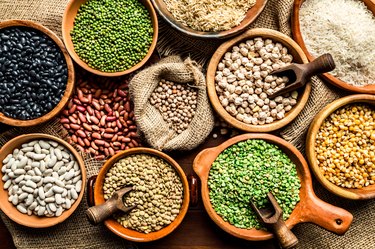
Lentils, soy and peas are significant sources of sulfur-containing amino acids in the plant world. One cup of boiled soybeans, or edamame, has 161 percent of the recommended dietary intake (RDI) for the sulfur-containing amino acid cysteine.
Beans and legumes are a great source of plant protein as well as fiber, B vitamins, iron, calcium, potassium, phosphorus and zinc, per the National Library of Medicine. Not sure how to include more beans in your diet? Try one of these delicious canned bean recipes.
7. Milk and Cheese
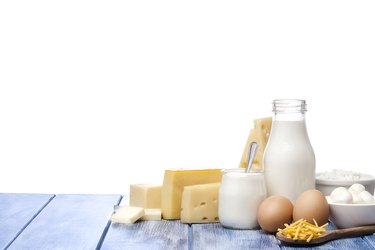
Cystine and methionine can be found in low amounts in milk, but the sulfur increases as the milk undergoes fermentation to produce cheese, according to a June 2017 study in the Journal of Dairy Science.
The breakdown of cysteine and methionine in the cheese-making process is an important part of the final flavor of the cheese. The bacteria used to ferment cheese increase the sulfur content, leading to either delicious or unpleasant flavors and smells, per the study.
8. Nuts and Seeds

Nuts and seeds like almonds, cashews, Brazil nuts, sunflower seeds and hemp seeds are nutritious sulphur-rich vegetarian foods. Brazil nuts are the highest sulfur-containing nut with 44 percent RDI for methionine and 30 percent cystine per 1-ounce serving.
A good source of sulfur, magnesium, and zinc, you need to be careful to not eat too many Brazil nuts in one sitting. Just four brazil nuts will put you at the upper limit for the mineral selenium, per the National Institutes of Health. Too much selenium can cause difficulty breathing, tremors and kidney or heart failure.
9. Dried Fruit
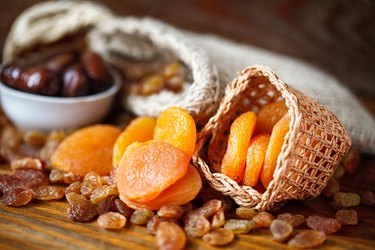
Naturally, fresh fruit doesn't have much sulfur. But to preserve dried fruit, many food manufacturers rely on sulfur dioxide to help the fruit maintain its natural color and flavor by preventing oxidation, per an April 2019 study in the Journal of Food Quality and Hazards Control.
Dried fruit like apricots, raisins, figs or dates makes eating fruit easier and more accessible for some people. While they are often higher in calories and sugar, eating dried fruit could improve your diet quality by eating more fiber, potassium and unsaturated fats, according to a July 2021 study in the Journal of the Academy of Nutrition and Dietetics.
10. Wine

All wine has sulfites, or sulfur dioxide, as a byproduct of yeast fermentation, but many winemakers also add additional sulfites to preserve the wine, per the University of California Davis. Organic wine in the United States can't add sulfites, but without this preservative, they are more likely to spoil and produce an off-flavor.
Does a glass of red wine give you a headache? It's a common misconception that the sulfur in wine is to blame. But, unless other foods that contain sulfites, like dried fruit, also make your head hurt, then sulfur is not likely the culprit. The "wine headache" is most likely caused by a combination of histamine, tannins, and the dehydrating effect of alcohol, according to Harvard Helalth Publishing.
- The Arthritis Foundation: "MSM"
- BMC Gastroenterology: "Efficacy of Glutathione for the Treatment of Nonalcoholic Fatty Liver Disease"
- Oregon State University: Linus Pauling Institute: Garlic and Organosulfur Compounds
- Molecules: "Potential Role of Sulfur-Containing Antioxidant Systems in Highly Oxidative Environments"
- Annual Review of Nutrition: "Sulfur as a Signaling Nutrient Through Hydrogen Sulfide"
- Mayo Clinic: "Sulfer (topical)"
- Molecules: "Allicin: Chemistry and Biological Properties"
- National Pesticide Information Center: "Sulfur"
- Food and Chemical Toxicology: "A case study involving allergic reactions to sulfur-containing compounds including, sulfite, taurine, acesulfame potassium and sulfonamides"
- Journal of Food and Drug Analysis: "Sulfur compounds identification and quantification from Allium spp. fresh leaves"
- Critical Reviews in Food and Science Nutrition: "Nrf2 targeting by sulforaphane: A potential therapy for cancer treatment"
- Antioxidants and Redox Signaling: "Dietary Sulforaphane in Cancer Chemoprevention: The Role of Epigenetic Regulation and HDAC Inhibition"
- USDA: "Broccoli"
- USDA: "Eggs"
- Amino Acids: "The role of methionine on metabolism, oxidative stress, and diseases"
- Society for Endocrinology: "Researchers may have found how high-protein diets cause weight loss"
- Food Chemistry: "The contribution of alliaceous and cruciferous vegetables to dietary sulphur intake"
- Mayo Clinic: "Omega-3 in fish: How eating fish helps your heart"
- FDA: "Advice about Eating Fish"
- USDA: "Boiled Soybeans"
- NIH: "Healthy food trends - beans and legumes"
- Journal of Dairy Science: "Contribution of the novel sulfur-producing adjunct Lactobacillus nodensis to flavor development in Gouda cheese"
- USDA: "Brazil Nuts"
- NIH: "Selenium"
- Journal of the Academy of Nutrition and Dietetics: "The Risk Assessment of Sulphite Intake through Dried Fruit Consumption in Hamadan, Iran"
- University of California Davis: "Sulfites"
- Harvard Medical School: "Ask the doctor: What causes red wine headaches?"